Marketers are constantly striving to develop campaigns that bring the best value to customers. As technology advances, we have more opportunities to create these superior campaigns — and consumers want them too. With zero patience for unhelpful, irrelevant, or “annoying” advertising, consumers require brands to bring them value moment by moment in their purchasing process. And historically, digital marketers have had to try their best to deliver this by reacting to dated ad campaign information. Not because we wanted to — it was just the best option we had.
Now, as technology has advanced, brands have more and more opportunities to deliver on one of the most important consumer demands — value-packed, in-the-moment advertising. And brands that strategically make the most of this are coming out ahead of their competitors.
As consumers discover new brands across their favorite feeds, marketers now need to know how Google Discovery ads can advance a holistic marketing strategy — and why it’s more important than ever for the modern search journey.
“Discovery ads are a huge opportunity. Marketers can easily engage customers at every stage of the buying process.”
-Keelan Crampsey, Paid Media Sr. Strategist
Google Discovery Ads at a Glance
59% of consumers have found their favorite brands while watching mobile videos, catching up on interests, or combing through emails.1 YouTube, Google’s Discover feed, and Gmail are highly popular places for information. And Discovery ads make sure your brand is top-of-mind in all three at just the right moment for the modern user.
Discover ads use impactful visuals with robust audience targeting features to create novel ad experiences that increase demand. Instead of waiting for searchers to show demand, Discovery ads proactively provide precise value to consumers.
Running on YouTube, Google Discover, and Gmail, Discovery ads are optimized for conversions.
Targeting Your Audience With Google Discovery Ads
Brands can scale to new customers and achieve conversion volume goals in several ways. Note, it’s important to first turn on audience expansion before moving to upper-funnel audiences.
- Remarketing + Customer Match
Marketers can leverage remarketing audiences and customer match through uploaded audiences from customer relationship management systems (i.e. Salesforce) or elsewhere. - Custom Intent Audiences
Additionally, marketers can create custom intent audiences based on recently searched Google keywords. - In-Market
To reach users deep into the research phase of the customer journey, marketers can use known websites or even competitors’ websites to move customers through the buying process. - Life Events
Less discussed, this targeting ecosystem engages searchers who are in the middle of major life events — getting married, moving, graduating college, etc. It can offer valuable insights to any campaign but will be most impactful for specific verticals such as real estate. - Affinity + Demographics
Reach new audiences and net users higher up in the sales funnel, especially for frequent grocery, big box, department, convenience store shoppers, restaurant goers, etc.
Leveraging the Modern Search Structure
As search algorithms evolve, marketers have a variety of Machine Learning tools to get the most out of every campaign. While it can be tempting to look at automation as competition, it’s actually a competitive edge for your brand — if you know how to leverage it.
Previously, marketers had to manually bid at the keyword level for 30 different ad groups and adjust these bids based on information that was no longer relevant — which we’ve lovingly dubbed “search classic.” This caused artificial constraints and created lots of room for human error. Ultimately, Machine Learning can automate and optimize this process exponentially more efficiently than the savviest marketer ever could — giving expert marketers more time to focus on the uniquely human elements of successful campaigns.
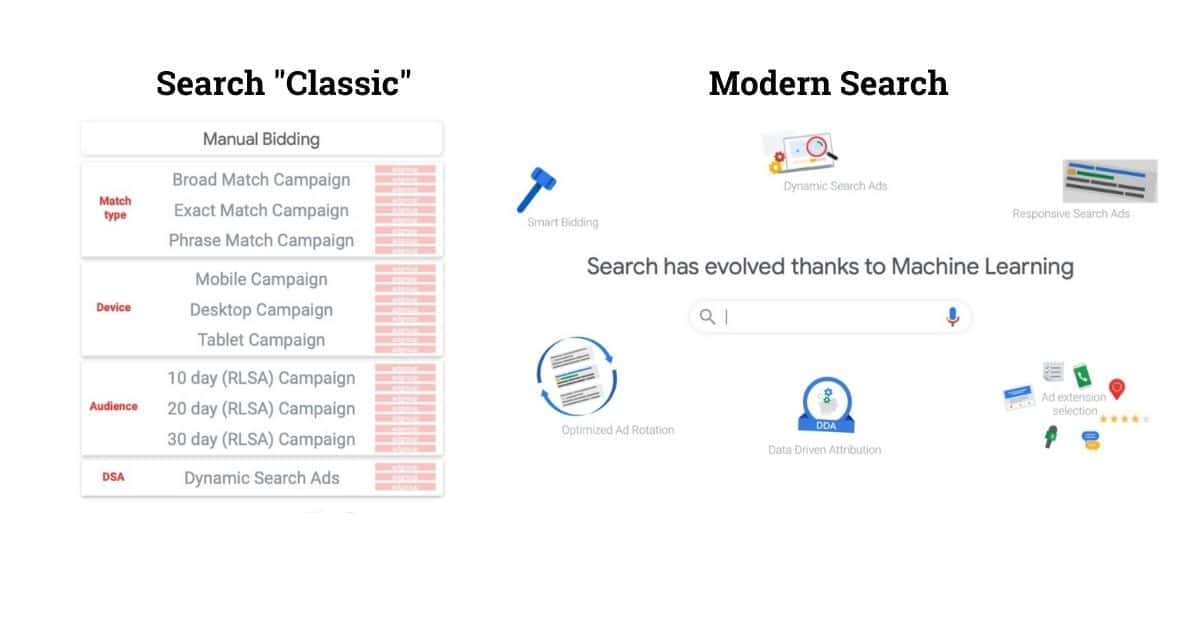
“Working with Google, we’ve identified that marketers can save around 20% of their time by using Google’s machine learning features.”
-Keelan Crampsey, Paid Media Sr. Strategist
Modern Search Structure, Machine Learning + Google Discover
Beyond more time, machine learning gives marketers many benefits to utilize in the modern search structure. This includes:
- Smart Bidding
- Optimized Ad Rotation
- Ad Extension Selection
- Data-driven Attribution
- Dynamic Search Ads
- Responsive Search Ads
Originally, the algorithm looked at which extension would drive performance best. Today, this has expanded into optimized ad rotation which uses its own insights to make informed decisions about which ad will likely drive the highest level of performance — something the human brain just can’t process as fast.
The modern search structure also offers 24/7 campaign management. Marketers can’t be solely focused on making tiny ad adjustments every minute of the campaign. So, allowing Machine Learning to handle the managerial tasks let’s marketers focus on what they bring to the table — ingenuity and creativity. Working with Google, we’ve identified that marketers can save around 20% of their time by using Google’s machine learning features.
With more time, marketers can stay agile — while ever efficient campaigns are being created behind the scenes. This Machine Learning optimization can streamline and inform decisions, helping marketers be more nimble in real-time.
Additionally, this advanced technology eliminates human error. When large groups of ads must be adjusted at lightning speed, errors are almost inevitable. Machine Learning takes the controls out of marketers’ hands. For example, they no longer need to worry about ad swaps — creative can be switched out faster and error-free.
Ultimately, modern search is just, plain better for brands, marketers, and customers.
- Superior performance with Machine Learning
- Ease of management with 20% more time for strategy
- Increased insights for strategic decision-making
- Decreased margin of error
- And more
For example, here’s how Smart Bidding can help brands outperform in search.
Smart bidding sets unique bids for each individual auction and query based on campaign goals and the likelihood of conversion. While manual bidding used past intent signals of users who’d already come and gone out your digital doors, Smart Bidding makes real-time bids. It layers thousands of different signals — location search query, operating system languages, etc. — into the very best option. And measures and optimizes per auction and query in the moment.
For instance, here are three different users that are searching for vaguely similar keywords with a different level of intent.
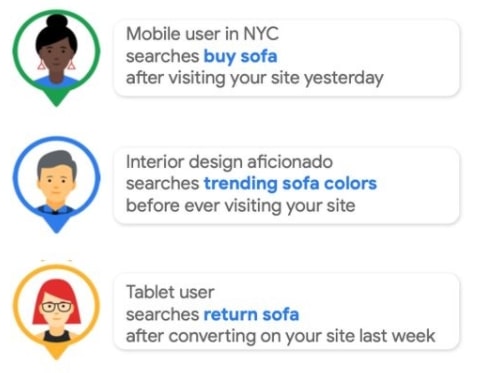
If a company was using manual bidding, these subtleties wouldn’t be factored into the ad campaign. But with Smart Bidding, the AI will recognize the differences and pull back the bid when necessary. A user who searched ”return sofa” after converting on your site last week shouldn’t see your ad — and Smart Bidding can make sure they don’t. Similarly, a user who’s just searching for interesting content related to interior design and has no intention of converting shouldn’t see your ad either. These are just a few examples of the thousands of behavioral signals that Google’s AI can recognize — and its algorithm will adjust the bid for.
Additionally, Smart Bidding pulls data from all your campaigns, account-wide data, to use for just a single one. Previously with portfolio bidding, marketers would compile signals and put them into a portfolio to use to the best of their abilities. Now, Smart Bidding can capture thousands of signals happening at once. Now, all of that data can be harnessed for every campaign individually.
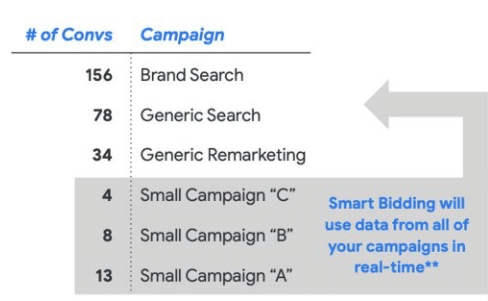
Quick Retail Client Case Study – Increased Performance on Low Volume Accounts with Discovery Ads in 2021
On March 3, 2021, we launched in low-impact modalities to measure success and reach. By April, our client saw a 188% increase in lead volume.
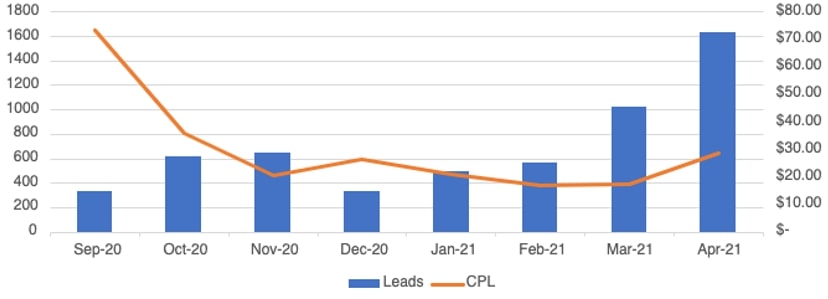
Launched on February 8, 2021, another account’s lead volume grew 200% by March.
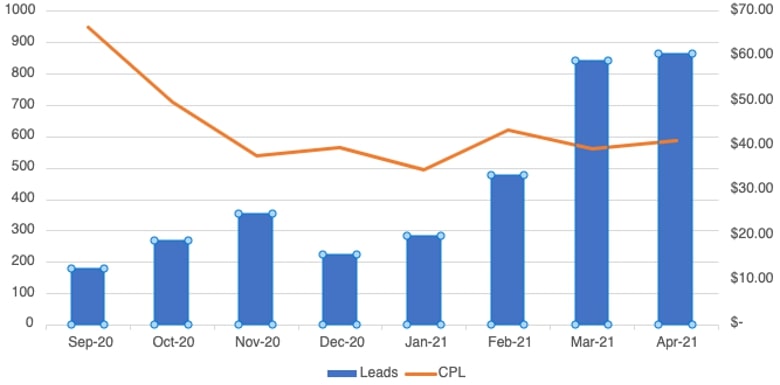
Machine Learning features have a clear impact on campaign outcomes. And as we continue utilizing this new technology, we’ll share our insights and findings.
Next Steps for Marketers
Ultimately, we know that utilizing the latest technology and insights will achieve optimal results. And Google Discovery ads give us an opportunity to do just this. What’s your current bidding structure? Are you utilizing Google’s latest Machine Learning features to create the most performant campaign possible? Save time and resources by using the latest AI to lean into the modern search structure while better serving your brand and budget.
To learn more about Google optimization, read The Ultimate Guide to Optimizing for Google News, Top Stories, and Discover.
1 Google/Ipsos Connect, Consumer Discovery Study, U.S., December 2018 of 2,001 US consumers age 18-54 who go online at least once a month.






